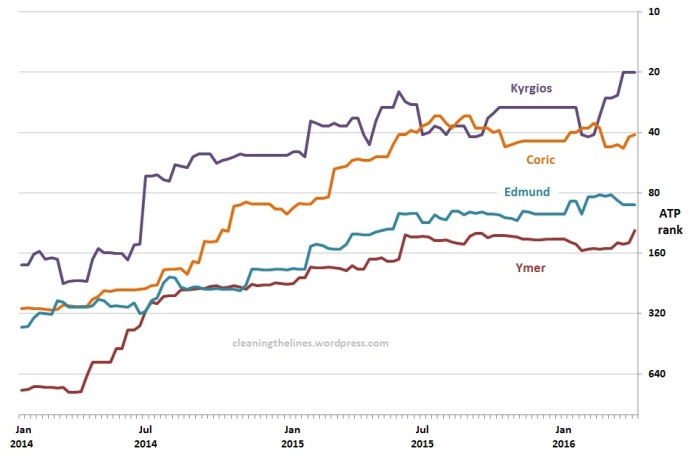In a marketing campaign known as #NextGen, the ATP in March this year started promoting 14 players aged 21 or under as a future generation of players to break through and threaten for titles. #NextGen may sound like a plan for renewable energy, and in some ways it is: its purpose must surely be preparation for a tour when the Big 4 have retired, making it commercially incumbent on the ATP now to build awareness of the players that will need to replace them. I’m fairly certain the ATP does not expect #NextGen to be direct or immediate replacements for the Big 4, but here are a few thoughts on #NextGen and especially when #NextGen is likely to be at the top of the game.
#NextGen probably contains a couple of “gens”….
Despite being of similar ages and in the top 200, being jointly branded as #NextGen is one of the few things they have in common. For example, the four #NextGen players at the ATP Estoril tournament this week occupy four clearly delineated levels on the tour. Elias Ymer, ranked outside the top 100, had to qualify for the main draw; Kyle Edmund’s ranking (92) was enough to get him into the main draw; Borna Coric, the Croatian, is the sixth seed with a ranking around 40; and Nick Kyrgios is the second seed (currently ranked 20th in the world).
In addition, #NextGen is emerging at different speeds and not always in one direction: it took Kyrgios six months to increase his ranking from 80 to 40 but another year to be ranked 20. Borna Coric, on the other hand, made the jump from 80 to 40 more quickly but has been becalmed at 40 for the last year. Edmund and Ymer’s career trajectories since reaching the top 150 have been less steep. See chart below.
Ranking evolution of #NextGen players entered at ATP Estoril 2016 (logarithmic scale)

…and it’s taking longer now to climb the rankings
The logarithmic scale applied above is not just so that the data can fit easily on one chart. The scale communicates what we understand intuitively – that it gets harder to climb through the ranks the nearer to the top you get. So in above chart, it is similarly difficult to climb from 40 to 20 as it is to go from 80 to 40. To increase their rankings, players have to amass more points at higher level tournaments (e.g. Masters 1000 events or grand slams), and with a couple of exceptions the #NextGen players are not yet doing that.
But why would they? Research published on this site shows that an ATP player now is on average 25 years old before he breaks into the top 100 as opposed to between 1980 and 2000 when he would be 22. For every player aged 21 or under that breaks into the top 100, there will be a player in their late 20s doing the same thing. 1 in 5 players will be ranked higher aged 30 or older than in any year in their late 20s. All of which raises the barriers to breaking through. #NextGen may not be at their peak until at least 2020.
Accordingly, when Federer and Big 4 friends zip up their racquet bags for the last time, we should expect the next set of household names to come from precisely those who are currently and consistently threatening at the tail end of tournaments: players such as Nishikori (aged 26), Raonic and Goffin (25), Cilic (27), Thiem (22), Tomic, Sock (both 23) and Dimitrov (24). Raonic was a recent Masters 1000 finalist in Indian Wells and a semi finalist at the Australian Open; Nishikori was a Masters 1000 finalist in Miami and a former US Open finalist; Goffin put together back-to-back semi-final appearances in Indian Wells and Miami. Cilic, with a US Open title, has arguably broken through, even if his ranking has not followed suit. Thiem’s recent record may just make him the hottest property of the lot.
In other words, forecasting the top of the ATP tree is currently an incremental evidence-based process, determined by a player’s record, founded on strength and fitness, helped by a grand slam seeding and impeded by prize money allocations that raise the barriers to reaching the top. Natural talent is not enough – and the days of 10 teenagers in the top 100 (at year end 1989) are long gone. And so unlike baldness, grand slam and Masters 100 titles are unlikely to skip a generation.
No one doubts that the #NextGen contains players that will stand atop the tour in the future. But without denying the possibility of one or two of those players reaching the top 10 sooner rather than later (especially Kyrgios), the odds of that happening en masse are not good. And so be patient with #NextGen: it might take a few years.



Pingback: 66. The Estoril Diaries: Day 5 | Cleaning the lines
Pingback: 68. Index of articles from Estoril | Cleaning the lines